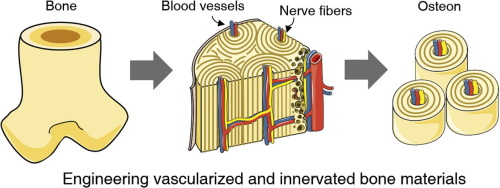当前位置:
X-MOL 学术
›
Mater. Today
›
论文详情
Our official English website, www.x-mol.net, welcomes your feedback! (Note: you will need to create a separate account there.)
Engineering vascularized and innervated bone biomaterials for improved skeletal tissue regeneration
Materials Today ( IF 24.2 ) Pub Date : 2018-05-01 , DOI: 10.1016/j.mattod.2017.10.005 Alessandra Marrella 1, 2 , Tae Yong Lee 1, 2, 3 , Dong Hoon Lee 1, 2 , Sobha Karuthedom 1, 2 , Denata Syla 1, 2 , Aditya Chawla 1, 2, 4 , Ali Khademhosseini 1, 2, 4, 5, 6 , Hae Lin Jang 1, 2, 4
Materials Today ( IF 24.2 ) Pub Date : 2018-05-01 , DOI: 10.1016/j.mattod.2017.10.005 Alessandra Marrella 1, 2 , Tae Yong Lee 1, 2, 3 , Dong Hoon Lee 1, 2 , Sobha Karuthedom 1, 2 , Denata Syla 1, 2 , Aditya Chawla 1, 2, 4 , Ali Khademhosseini 1, 2, 4, 5, 6 , Hae Lin Jang 1, 2, 4
Affiliation

|
Blood vessels and nerve fibers are distributed throughout the entirety of skeletal tissue, and play important roles during bone development and fracture healing by supplying oxygen, nutrients, and cells. However, despite the successful development of bone mimetic materials that can replace damaged bone from a structural point of view, most of the available bone biomaterials often do not induce sufficient formation of blood vessels and nerves. In part, this is due to the difficulty of integrating and regulating multiple tissue types within artificial materials, which causes a gap between native skeletal tissue. Therefore, understanding the anatomy and underlying interaction mechanisms of blood vessels and nerve fibers in skeletal tissue is important to develop biomaterials that can recapitulate its complex microenvironment. In this perspective, we highlight the structure and osteogenic functions of the vascular and nervous system in bone, in a coupled manner. In addition, we discuss important design criteria for engineering vascularized, innervated, and neurovascularized bone implant materials, as well as recent advances in the development of such biomaterials. We expect that bone implant materials with neurovascularized networks can more accurately mimic native skeletal tissue and improve the regeneration of bone tissue.
中文翻译:

工程血管化和神经支配的骨生物材料以改善骨骼组织再生
血管和神经纤维分布在整个骨骼组织中,通过提供氧气、营养物质和细胞,在骨骼发育和骨折愈合过程中发挥重要作用。然而,尽管成功开发了可以从结构角度替代受损骨的仿骨材料,但大多数可用的骨生物材料通常不能诱导血管和神经的充分形成。在某种程度上,这是由于在人造材料内整合和调节多种组织类型的困难,这导致了天然骨骼组织之间的差距。因此,了解骨骼组织中血管和神经纤维的解剖结构和潜在的相互作用机制对于开发能够重现其复杂微环境的生物材料非常重要。从这个角度来看,我们以耦合的方式强调骨骼中血管和神经系统的结构和成骨功能。此外,我们还讨论了工程血管化、神经支配和神经血管化骨植入材料的重要设计标准,以及此类生物材料开发的最新进展。我们期望具有神经血管网络的骨植入材料能够更准确地模仿天然骨骼组织并改善骨组织的再生。
更新日期:2018-05-01
中文翻译:

工程血管化和神经支配的骨生物材料以改善骨骼组织再生
血管和神经纤维分布在整个骨骼组织中,通过提供氧气、营养物质和细胞,在骨骼发育和骨折愈合过程中发挥重要作用。然而,尽管成功开发了可以从结构角度替代受损骨的仿骨材料,但大多数可用的骨生物材料通常不能诱导血管和神经的充分形成。在某种程度上,这是由于在人造材料内整合和调节多种组织类型的困难,这导致了天然骨骼组织之间的差距。因此,了解骨骼组织中血管和神经纤维的解剖结构和潜在的相互作用机制对于开发能够重现其复杂微环境的生物材料非常重要。从这个角度来看,我们以耦合的方式强调骨骼中血管和神经系统的结构和成骨功能。此外,我们还讨论了工程血管化、神经支配和神经血管化骨植入材料的重要设计标准,以及此类生物材料开发的最新进展。我们期望具有神经血管网络的骨植入材料能够更准确地模仿天然骨骼组织并改善骨组织的再生。


























 京公网安备 11010802027423号
京公网安备 11010802027423号